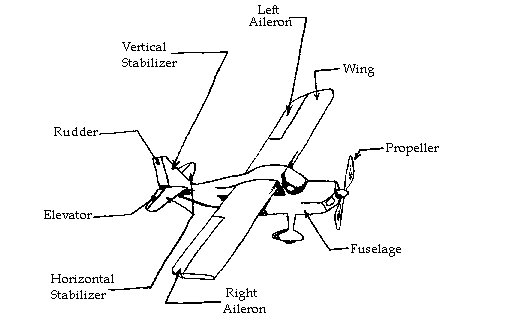Want to learn to be an RC Pilot?
Let’s begin by reviewing the
parts of a plane.

Basically, all planes have the same parts. They are require something that provides thrust (i.e. propellor or turbine), something to create lift (the wing) and parts to steer the plane (rudder, elevator and aileron.
Lets go over what the controls do.

Ailerons provide movement of the plane along the
longitudinal axis. When the right
aileron goes up, the left aileron goes down and vice-versa. This allows the airplane to “Roll”.
Rudder provides movement of the plane along the vertical
axis. This points the nose of the plane
in a given direction and allows the pilot to steer the plane just as a driver
steers a car.
Elevator provides movement of the plane along lateral
axis. This allows the plane to go up
and down.
So what do you need to become
an RC Pilot?
AMA Membership
Airplane
Transmitter
Field Box (starter, glow starter, power panel, 12v battery)
AMA Membership: This is a requirement at virtually all
flying clubs in N. America. This membership
includes a subscription to Model Aviation magazine but also provides
supplemental insurance to cover any mishaps which may occur. You may download the official AMA
application form by clicking
here. The official site to AMA is http://www.modelaircraft.org/.
The Airplane: When
choosing your first plane, the recommended type of plane is what is generally
referred to as a “Trainer”. A good
trainer will be durable, stable at low speeds and will be able to correct
itself when the student pilots release the controls. Be sure that when you are choosing your
first plane that you get plenty of advice from your local hobby shop or local
flying club. Familiar planes such as
P-51 Mustangs, Cap 230s, Extras and even Piper Cubs make terrible
trainers. Although you may have the
urge to go after the best looking, fastest or most aerobatic plane, you will
be more satisfied and comfortable learning on a “standard” trainer. A good model to begin with is the Superstar
made by Hobbico. This kit is available as a complete package containing
the airplane, transmitter, engine and servos. All you need to do is finish
by epoxying the wing halves together and charge the batteries!!!
The Transmitter: This is the “steering wheel” of the plane. Most newer transmitters operate on the 72Mhz or 50Mhz bands within the US. Each frequency is broken down further into “Channels”. Every flying club will have rules governing the use and “impound” of radio transmitters so it is very important to learn the rules of the field prior to turning a radio on. Turning on a radio that is not properly checked in may cause a wrecked plane or worse an injury. The most common aircraft radio is 4 channels. Each channel controls a different control surface on the plane. Most common are Elevator, Aileron, Throttle and Rudder. Transmitters are also available in models up to 12 channels. Additional channels may be used for retractable landing gear, flaps, etc. Recently, computer radios have become very affordable. Computer radios are capable of storing trims for multiple models, mixing functions (i.e. Delta Wing and flaperons). Transmitters are also available in single stick versions which are typically 3 channels. This allows you to control 3 different functions (i.e. throttle, rudder and elevator). Since this is your first airplane, it is highly recommended that you get at least a 4 channel radio. If you have the available money, a computer radio will save you in the long run.
Field Box: The field box is essentially a tool box to get your plane started. When building or buying a field box, you will want to consider these factors.
· How will I crank the engine? Usually, this is done with a 12v starter. This is a motor that turns the engine.
· How will I provide energy to the “glow plug” or spark plug? A glow starter provides the necessary 1.5v to get the “fire” started. These are available in rechargeable “cordless” models and a corded model, which connects to your power panel.
· Where will the power to start the engine come from? Either a 12v power panel, which provides hook-ups for the starter, glow starter and fuel pump or any 12v battery will do. The most common found in field boxes are sealed lead-acid batteries. These batteries provide plenty of amperage and have enough capacity to last several weeks without charging.
· A good field box will also contain screwdrivers, pliers, prop-reamer and plenty of extra propellers. These items will keep your plane flying if a part happens to come loose at the field. It is also good to carry 5 minute epoxy and CA glue in case of any mishaps.
· Plenty of paper towels and cleaner. Glow fuel can be MESSY!! It is important to clean your plane at the end of each flying day to keep the plane’s covering looking good but also keeps the oil from staining.
Now that you know what it takes to fly an RC airplane, click here to learn how you can join the NCRC Hawks!!